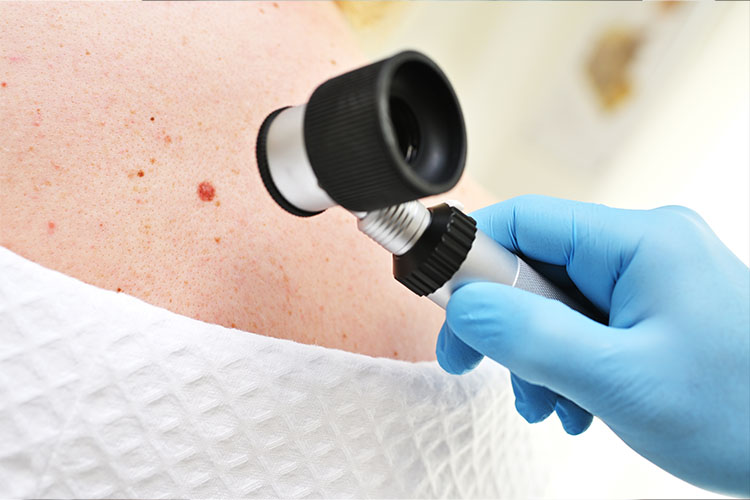Overview
Skin cancer is the abnormal growth of skin cells, often triggered by excessive exposure to ultraviolet (UV) radiation from the sun or tanning beds. It is the most common type of cancer worldwide, affecting millions of people each year. While anyone can develop skin cancer, individuals with fair skin, a history of sunburns, or prolonged sun exposure are at higher risk. Skin cancer typically develops in areas frequently exposed to the sun, such as the face, neck, arms, and legs, though it can appear anywhere on the body.
The effects of skin cancer vary depending on its type. The three main types are basal cell carcinoma (BCC), squamous cell carcinoma (SCC), and melanoma. BCC and SCC are generally less aggressive and easier to treat, but if left untreated, they can cause significant damage to surrounding tissues. Melanoma, although less common, is far more dangerous as it has a higher likelihood of spreading to other parts of the body, leading to life-threatening complications.
Treatment for skin cancer depends on its type, size, and stage. Early-stage cancers are often treated with minor surgical procedures to remove the affected tissue. More advanced cases may require additional treatments, such as radiation therapy, chemotherapy, immunotherapy, or targeted therapy. Melanoma treatment, in particular, may involve a combination of surgery and systemic therapies to manage the disease.
Prevention is a key component of managing skin cancer risk. Regular use of sunscreen, wearing protective clothing, avoiding tanning beds, and seeking shade during peak UV hours can significantly reduce the likelihood of developing skin cancer. Early detection through routine skin self-examinations and professional check-ups can improve treatment outcomes and reduce the risk of severe complications.
Table of Contents
Overview
Skin cancer is the abnormal growth of skin cells, often triggered by excessive exposure to ultraviolet (UV) radiation from the sun or tanning beds. It is the most common type of cancer worldwide, affecting millions of people each year. While anyone can develop skin cancer, individuals with fair skin, a history of sunburns, or prolonged sun exposure are at higher risk. Skin cancer typically develops in areas frequently exposed to the sun, such as the face, neck, arms, and legs, though it can appear anywhere on the body.
The effects of skin cancer vary depending on its type. The three main types are basal cell carcinoma (BCC), squamous cell carcinoma (SCC), and melanoma. BCC and SCC are generally less aggressive and easier to treat, but if left untreated, they can cause significant damage to surrounding tissues. Melanoma, although less common, is far more dangerous as it has a higher likelihood of spreading to other parts of the body, leading to life-threatening complications.
Treatment for skin cancer depends on its type, size, and stage. Early-stage cancers are often treated with minor surgical procedures to remove the affected tissue. More advanced cases may require additional treatments, such as radiation therapy, chemotherapy, immunotherapy, or targeted therapy. Melanoma treatment, in particular, may involve a combination of surgery and systemic therapies to manage the disease.
Prevention is a key component of managing skin cancer risk. Regular use of sunscreen, wearing protective clothing, avoiding tanning beds, and seeking shade during peak UV hours can significantly reduce the likelihood of developing skin cancer. Early detection through routine skin self-examinations and professional check-ups can improve treatment outcomes and reduce the risk of severe complications.
When to See a Doctor
Early detection of skin cancer can significantly improve treatment outcomes, making it crucial to consult a medical professional if you notice any unusual changes in your skin. While many skin abnormalities are benign, some can signal the presence of cancer or precancerous conditions that require medical attention. Knowing when to seek help ensures prompt diagnosis and management.

Signs to see a doctor:
- Changes in the size, shape, or color of a mole or spot. If a mole or skin spot evolves in size, develops irregular borders, or changes color, it may be a sign of melanoma or another form of skin cancer.
- The appearance of a new skin lesion. New growths, especially those that look different from other moles or spots on your body, should be examined by a healthcare provider.
- Non-healing wounds or persistent sores. Sores that do not heal within a few weeks, or that repeatedly heal and reopen, may indicate basal or squamous cell carcinoma.
- Itching, bleeding, or tenderness in a skin area. Persistent irritation, bleeding, or pain in a mole, spot, or lesion can be a warning sign of skin cancer and warrants immediate evaluation.
- A growth with a pearly, waxy, or scaly appearance. Skin cancers such as basal cell carcinoma may present as shiny bumps, while squamous cell carcinoma may appear rough or scaly.
Consulting a dermatologist or primary care physician promptly is vital if you observe any of these symptoms. Delaying medical attention can allow the condition to progress, making treatment more complex and less effective. Regular skin examinations by a professional are also recommended for individuals at high risk, such as those with a family history of skin cancer or a history of extensive UV exposure.
What Type of Doctor to Seek
If you suspect skin cancer, the first medical professional to consult is a dermatologist, a doctor specializing in skin, hair, and nail conditions. Dermatologists are trained to evaluate, diagnose, and treat skin cancers and other abnormalities. They can perform a physical examination, use tools like dermoscopy for closer inspection, and, if necessary, conduct a skin biopsy to confirm the presence of cancer. A dermatologist is often the primary point of contact for identifying and managing skin cancer, particularly in its early stages.

In cases of advanced or complicated skin cancer, such as melanoma or cancers that have spread to other areas, your dermatologist may refer you to other specialists. These might include oncologists, who specialize in cancer treatment, or Mohs surgeons, experts in a specialized surgical technique for removing skin cancer while preserving healthy tissue. Collaborative care among these specialists ensures comprehensive treatment tailored to the type and stage of the cancer.
What to Expect from Your Visit to a Doctor
When you visit a doctor for suspected skin cancer, the first step will typically involve a thorough discussion of your medical history and any symptoms you’ve noticed. The doctor will ask about changes in your skin, exposure to sunlight or tanning beds, and any family history of skin cancer. This conversation helps the doctor assess your risk factors and determine the next steps in the evaluation process.
The physical examination focuses on the area of concern and may include a full-body skin check to identify other potential abnormalities. If the doctor finds a suspicious spot, they might use a dermatoscope, a magnifying tool, to examine it more closely. If necessary, they will perform a biopsy, a procedure in which a small sample of skin is removed for laboratory analysis. The biopsy is usually quick, done under local anesthesia, and helps confirm whether the lesion is cancerous. Based on the results, the doctor will discuss treatment options or next steps with you, including potential referrals to specialists for further care.
Skin Cancer Treatment Options

Skin cancer is a serious condition, but there are various effective treatment options depending on the type, location, and stage of the cancer. Early diagnosis often means less invasive treatments and better outcomes. Below are some common treatments available for managing skin cancer.
- Minor surgery. Minor surgical procedures are among the most common treatments for skin cancer. These involve removing cancerous tissue from the skin, often with minimal bleeding or scarring. For more advanced cases where the cancer has spread to other parts of the body, major surgery might be required, which involves more extensive procedures to remove affected tissues or organs.
- Chemotherapy. When surgery is not an option, chemotherapy can be used to target and kill cancer cells. This treatment may involve oral medications, injectable drugs, or topical creams applied directly to the affected skin. The approach depends on the type and severity of the cancer.
- Radiation therapy. Radiation therapy uses high-energy light beams to destroy cancer cells. It is often used for cancers in sensitive or difficult-to-treat areas, such as the face, where surgical intervention may be more complex. This method is non-invasive but may require multiple sessions.
- Cryotherapy. Cryotherapy involves applying liquid nitrogen to freeze and destroy cancer cells. Once frozen, the affected tissue can be easily removed. This treatment is effective for small, localized skin cancers or precancerous lesions.
- Curettage and electrodessication. In this method, a spoon-shaped surgical instrument is used to scrape away cancer cells (curettage). Afterward, an electric needle is used to burn and destroy any remaining cancerous tissue (electrodessication). This approach is suitable for certain types of skin cancer, particularly basal and squamous cell carcinomas.
- Immunotherapy. Immunotherapy enhances the body’s immune system to fight cancer cells. For skin cancer, a medicated cream is often applied to the affected area to stimulate the immune system to target and destroy cancer cells.
Skin cancer, though alarming, can often be effectively treated if caught early. Regular skin checks and prompt medical attention are key to preventing complications. Early detection not only simplifies treatment but also significantly improves the chances of recovery.
Skin Cancer Prognosis
The prognosis for skin cancer depends on the type of treatment chosen and the stage at which the cancer is detected. Most treatment options offer favorable outcomes, particularly when the cancer is diagnosed early. Below is an overview of the typical prognosis associated with each treatment method.
- Minor surgery. For early-stage skin cancer, minor surgery often results in complete removal of the cancer with a high cure rate. The prognosis is excellent, and recurrence is rare if all cancer cells are successfully removed.
- Chemotherapy. Chemotherapy is generally used for more advanced or metastatic skin cancers. While it can effectively shrink or control tumors, the prognosis varies depending on how far the cancer has spread. It is less curative for late-stage cancers but can improve quality of life.
- Radiation therapy. This treatment is highly effective for localized cancers, particularly in areas where surgery is challenging. The prognosis is good for non-melanoma skin cancers but may be more guarded for advanced melanomas requiring additional therapies.
- Cryotherapy. Cryotherapy works well for small, superficial cancers and precancerous lesions. The prognosis is excellent for early-stage conditions, but it is less effective for deeper or more invasive cancers.
- Curettage and electrodessication. This method is very successful for basal and squamous cell carcinomas when caught early. The cure rate is high, but it may not be suitable for more advanced cancers or those in cosmetically sensitive areas.
- Immunotherapy. Immunotherapy has shown promising results, particularly for advanced melanoma. It can lead to long-term remission in some patients, although outcomes can vary depending on individual response and the cancer’s aggressiveness.
With early detection and appropriate treatment, skin cancer is often curable, and long-term outcomes are highly favorable. Regular follow-ups and preventive measures help ensure continued health and reduce the risk of recurrence.


